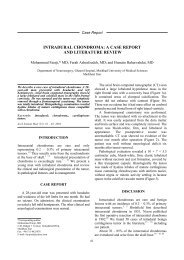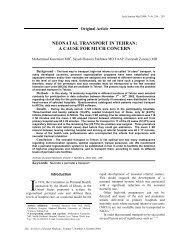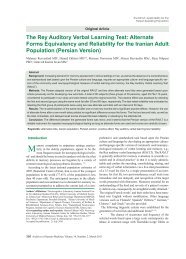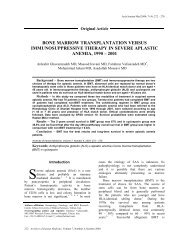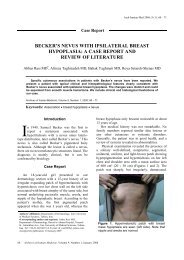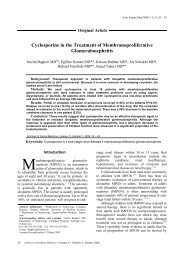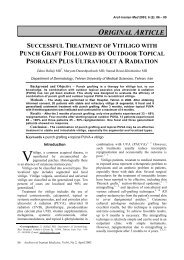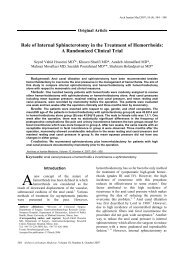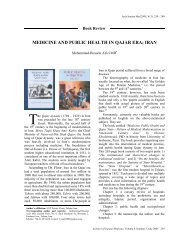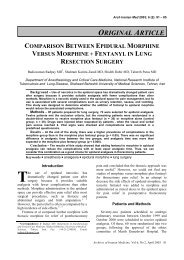ANTERIOR TRANSPOSITION OF THE INFERIOR OBLIQUE ...
ANTERIOR TRANSPOSITION OF THE INFERIOR OBLIQUE ...
ANTERIOR TRANSPOSITION OF THE INFERIOR OBLIQUE ...
You also want an ePaper? Increase the reach of your titles
YUMPU automatically turns print PDFs into web optimized ePapers that Google loves.
Arch Iranian Med 2003; 6 (3): 200 – 203ORIGINAL ARTICLE<strong>ANTERIOR</strong> <strong>TRANSPOSITION</strong> <strong>OF</strong> <strong>THE</strong> <strong>INFERIOR</strong><strong>OBLIQUE</strong> MUSCLE FOR TREATMENT <strong>OF</strong> SUPERIOR<strong>OBLIQUE</strong> PALSY WITH 10 TO 25 PRISM DIOPTERSHYPERDEVIATION IN PRIMARY POSITIONMajid Farvardin MD • , Shahin Nazerpoor MD, Mohsen Farvardin MDDepartment of Ophthalmology, Shiraz University of Medical Sciences, Shiraz, IranBackground – Weakening of the inferior oblique muscle is the procedure of primaryimportance in the treatment of patients with superior oblique palsy, Knapp’s classes I and III. Inthis study, the effectiveness of anterior transposition of the inferior oblique muscle in thetreatment of these patients was evaluated.Methods – Twenty three patients with superior oblique palsy, Knapp’s classes I and IIIunderwent anterior transposition of the inferior oblique muscle. These patients had 10 to 25prism diopters (PD) hyperdeviation in primary position. The tip of the disinserted muscle wassutured to the sclera parallel and adjacent to the lateral border of the inferior rectus muscleinsertion. The prism and alternate cover test measurements were performed in all cardinalpositions of gaze before and six months after surgery.Results – The mean reduction of hyperdeviation measured 14.9 PD in the primary position,23 PD in adduction, 25.2 PD in elevation and adduction, and 18.1 PD in depression andadduction. There was no hypotropia in the primary position or limitation of upgaze.Postoperative hyperdeviation in the primary position was 5 PD or less in 21 out of 23 patients.Conclusion – The anterior transposition of the inferior oblique muscle is very effective ineliminating hyperdeviation in patients with superior oblique palsy, Knapp’s classes I and III. Upto 25 PD of hyperdeviation reduction in the primary position can be achieved. If this type ofanterior transposition is used, hypotropia in the primary position or limitation of upgaze willpossibly not occur.Archives of Iranian Medicine, Volume 6, Number 3, 2003: 200 – 203.Keywords • anterior transposition • inferior oblique muscle • superior oblique palsyIntroductionSuperior oblique palsy is the most commonform of paralytic strabismus. It may beunilateral or bilateral. The diagnosis ofsuperior oblique palsy is based on the presence ofhypertropia, usually greatest in the nasal field ofthe involved eye. 1In 1974, Knapp classified superior obliquepalsy according to the pattern of vertical deviationmeasured in nine cardinal positions of gaze. 2Classes I, II, and III are the most common types. 3•Correspondence: M. Farvardin MD, Department ofOphthalmology, Shiraz University of Medical Sciences, Shiraz,Iran. Fax: +98-711-6279374, E-mail: farvardin@sums.ac.ir.Surgical treatment of superior oblique palsy isstill a controversial issue. Because the majority ofpatients with unilateral superior oblique palsypresent with significant overaction of the ipsilateralinferior oblique, weakening of this muscle is theprocedure of primary importance. The methodscommonly employed include recession, myectomy,and disinsertion. Resolution of 10 prism diopters(PD) of hyperdeviation in primary position iscommon after such procedures. 4 Anteriortransposition of the inferior oblique muscle hasrecently been introduced as a means for weakeningof overacting inferior oblique muscles. 5 Anteriortransposition may work in part by converting theinferior oblique muscle from an elevator to a200Archives of Iranian Medicine, Vol 6, No 3, July 2003
M. Farvardin, S. Nazerpoor, M. FarvardinTable 1. Characteristics of the patients.No. of patientsAge at the time of surgery(yr)depressor of the globe. In theory, this would beuseful in treating the inferior oblique overaction,associated with superior oblique palsy. 6 There arefew reports with unclear results on using anteriortransposition of the inferior oblique muscle for thetreatment of patients with superior oblique palsy.In this study, the effectiveness of this procedure inthe treatment of patients with superior obliquepalsy, Knapp’s classes I and III and 10 to 25 PDhyperdeviation in primary position was evaluated.Patients and MethodsThe subjects of this prospective study consistedof 23 patients with unilateral superior obliquepalsy in Khalili Hospital, Shiraz University ofMedical Sciences, Shiraz, Iran. The criteria for thediagnosis of unilateral superior oblique palsySexKnapp’s classPreoperative deviationin primary position(PD)1 13 F I 20LH2 20 M I 20RH-25ET3 2 M I 20RH-5ET4 14 M III 25LH-10ET5 4 F I 15RH-20ET6 10 M I 14LH-25ET7 5 F III 12RH8 11 F I 12LH-5ET9 15 F III 15LH-25ET10 13 F III 20RH-25XT11 18 F III 15RH-25XT12 21 F III 20LH-10XT13 28 M III 20RH-30ET14 16 M III 14LH15 20 F III 23LH16 6 F I 10RH-20ET17 39 M III 22RH18 12 M I 20LH-25XT19 11 F I 16RH20 5 M III 15RH-30XT21 8 F III 16LH22 4 M I 15LH-12ET23 10 F III 15RHPD = prism diopters; F = female; M = male; ET = esotropia; XT = exotropia; LH = left hypertropia; RH = right hypertropia; yr = year.included hypertropia in the primary position,increase in the nasal field of the involved eye, andpositive Bielschowsky head tilt test.Ocular deviation was measured in the ninecardinal positions at distance while, the bestcorrected vision and accommodative targets wereused to control fixation. The prism and alternatecover test method were used.The surgical technique of Elliott and Nankin foranterior transposition of the inferior obliquemuscle was used. The tip of the disinserted inferioroblique muscle was sutured to the sclera, justanterior to the temporal insertion of the inferiorrectus muscle. In the case of associated horizontaldeviation, appropriate horizontal surgery was donein combination with anterior transposition of theinferior oblique muscle.Six months after the surgery, ocular deviationTable 2. Postoperative results.Gaze positionPreoperative hyperdeviation No. of patients Mean reduction of hyperdeviation(PD)(PD)Primary0 – 15 11 12.916 – 25 12 16.8AdductionElevation/adductionDepression/adductionPD = prism diopters.0 – 15 1 1516 – 25 11 2126 – 45 11 25.50 – 15 1 1516 – 25 8 19.526 – 45 14 29.20 – 15 4 13.116 – 25 15 17.826 – 45 4 24Archives of Iranian Medicine, Vol 6, No 3, July 2003 201
Anterior Transposition of the Inferior Oblique Muscle for Treatment of Superior Oblique PalsyFigure. Hyperdeviation in the primary position before (open circle) and after (closed circle) surgery.was measured again. A patient was considered tohave a successful surgical outcome if thepostoperative hyperdeviation in the primaryposition was 5 PD or less and the maximumpostoperative hyperdeviation in an obliquediagnostic position of gaze was 10 PD or less.ResultsThe twenty three studied patients consisted ofthirteen females and ten males. The average age atthe time of surgery was 13.3 years (age range, 2 to39 years). Thirteen patients had their palsy frombirth or early infancy. In three cases, the palsy wasassociated with previous head trauma and wasconsidered traumatic in origin. In seven cases, thecause of the palsy was unknown. Twelve patientshad right-sided palsy while the other eleven hadleft-sided palsy. There were ten patients withKnapp’s class I and thirteen with Knapp’s class IIIpalsy. Table 1 shows age, sex, Knapp’s class,preoperative deviation in the primary position, andside of palsy in each patient.The average of preoperative hyperdeviation was17.1 PD (10 to 25 PD) in the primary position,25.2 PD (14 to 35 PD) in adduction, 29.3 PD (20 to45 PD) in elevation and adduction, and 21.1 PD(10 to 30 PD) in depression and adduction.Preoperative and postoperative hyperdeviationsin the primary position for each patient are shownin Figure. The mean reduction of hyperdeviation inthe four primary positions of gaze was calculatedto determine the effectiveness of the anteriortransposition of the inferior oblique muscle (shownin Table 2). The average reduction of 14.9 PD inthe primary position, 23 PD in adduction, 25.2 PDin elevation and adduction, and 18.1 PD indepression and adduction were achieved. Theaverage reduction of hyperdeviation in all positionsof gaze was 14.4 PD.Anterior transposition of the inferior obliquemuscle was considered successful in 21 out of 23patients (91% success rate). No surgicalcomplication was seen. There was no hypotropia inthe primary position or limitation of upgaze.DiscussionThe anterior transposition of the inferioroblique muscle was highly effective in eliminatinghyperdeviation in patients with superior obliquepalsy, Knapp’s classes I and III. In our patients, theaverage reduction of hyperdeviation in all positionsof gaze was 14.4 PD. In a comparable study usinginferior oblique myectomy, this quantity wasshown to be 11.91 PD. 7 In our study, only twopatients (9%) needed a second surgery forhyperdeviation. In a comparable study, usingrecession of the inferior oblique muscle, the needfor a second surgery was near 20%. 8202Archives of Iranian Medicine, Vol 6, No 3, July 2003
M. Farvardin, S. Nazerpoor, M. FarvardinIn our patients, the extent of vertical correctionwas roughly proportional to preoperativehyperdeviation. The average reduction ofhyperdeviation in the primary position was 12.9PD in patients with 10 to 15 PD of preoperativehyperdeviation and 16.8 PD in those with 16 to 25PD of preoperative hyperdeviation. In two otherreports, 12 and 17 PD reduction of hyperdeviationin the primary position were achieved with anteriortransposition of the inferior oblique muscle. 6, 9 Thisdifference could be due to the difference inpreoperative hyperdeviations in these two studies.The most important complications reported forthe anterior transposition of the inferior obliquemuscle are hypotropia in the primary position andlimitation of upgaze. Bremer et al have reportedhypotropia in the primary position and limitationof upgaze in three patients with superior obliquepalsy, following anterior transposition of theinferior oblique muscle. 10 However, May et alfound that no hypotropia occurred after unilateralanterior transposition surgery in patients withsuperior oblique palsy. 9 Ziffer et al found thatanterior transposition surgery may lead tolimitation of upgaze, but this limitation is not acosmetically noticeable or functionallyunacceptable result. 11 Primary-position hypotropiaand marked limitation of upgaze may be due tooveranteriorization of the inferior oblique muscle.Kushner noted that the transposition of the inferioroblique muscle to more than 1 mm anterior to theinsertion point of the inferior rectus muscle maycause limitation of upgaze. 12 Hypotropia in theprimary position and the limitation of upgaze werenot observed in our study. In our patients the tip ofthe disinserted inferior oblique muscle was suturedto the sclera, at a point less than 1 mm anterior tothe temporal insertion of the inferior rectus muscle.Using this type of anterior transposition of theinferior oblique muscle, primary-positionhypotropia or limitation of upgaze will possiblynot occur.References1 von Noorden GK. Binocular Vision and OcularMotility. 5th ed. St. Louis: Mosby; 1996.2 Knapp P. Classificatin and treatment of superioroblique palsy. Am Orthopt J. 1974; 24: 18 – 22.3 von Noorden GK, Murray E, Wong SY. Superioroblique paralysis. A review of 270 cases. ArchOphthalmol. 1986; 104: 1771 – 6.4 Helveston EM. Diagnosis and management ofsuperior oblique palsy. Int Ophthalmol Clin. 1985;25: 69 – 77.5 Elliott RL, Nankin SJ. Anterior transposition of theinferior oblique. J Pediatr Ophthalmol Strabismus.1981; 18: 35 – 8.6 Muchnick RS, McCullough DH, Strominger MB.Comparison of anterior transposition and recession ofthe inferior oblique muscle in unilateral superioroblique paresis. J Am Assoc Ophthalmol Strabismus.1998; 2: 340 – 3.7 Tossi SH, von Noorden GK. Effect of isolated inferioroblique muscle myectomy in the management ofsuperior oblique msucle palsy. Am J Ophthalmol.1979; 88: 602 – 8.8 Haugen OH, Stole MP, Dannevig L, et al. Paresis ofthe superior oblique eye muscle [in Norwegian].Tidsskr Nor Laegeforen. 1998; 118: 2141 – 3.9 May MA, Beauchamp CR, Price RL. Recession andanterior transposition of the inferior oblique fortreatment of superior oblique palsy. Graefes ArchClin Exp Ophthalmol. 1988; 226: 407 – 9.10 Bremer DL, Rogers CL, Quick LD. Primary-positionhypotropia after anterior transposition of the inferioroblique. Arch Ophthalmol. 1986; 104: 229 – 32.11 Ziffer AJ, Isenberg SJ, Elliott RL, et al. The effect ofanterior transposition of the inferior oblique muscle.Am J Ophthalmol. 1993; 116: 224 – 7.12 Kushner BJ. Restriction of elevation in abductionafter inferior oblique anteriorization. J Am AssocPediatr Ophthalmol Strabismus. 1997; 1: 55 – 62.Archives of Iranian Medicine, Vol 6, No 3, July 2003 203



